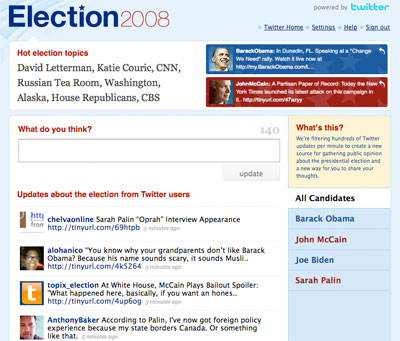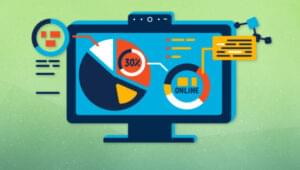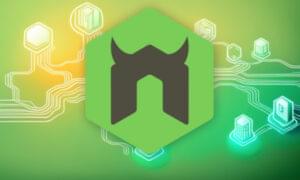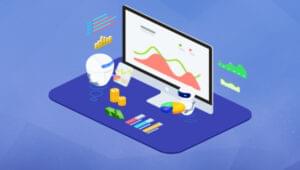 With the US presidential elections just over a month away, a lot of sites are rushing to get in on the action and launch a candidate watching page. Site’s like YouTube, Digg, MySpace and even PriceGrabber have had them for ages. A late entry is Twitter, which launched an Election mashup tonight. Given how much Twitter has been a hotbed for election chatter in the United States during the course of the election cycle, it makes sense that the company would try to feed off the publicity with an official channel.
With the US presidential elections just over a month away, a lot of sites are rushing to get in on the action and launch a candidate watching page. Site’s like YouTube, Digg, MySpace and even PriceGrabber have had them for ages. A late entry is Twitter, which launched an Election mashup tonight. Given how much Twitter has been a hotbed for election chatter in the United States during the course of the election cycle, it makes sense that the company would try to feed off the publicity with an official channel.
The site, dubbed simply “Election 2008,” pulls in tweets that it knows to be about the US election, streams them in real time, and parses them into separate topical pages for the candidates and their running mates, Barack Obama, John McCain, Joe Biden, and Sarah Palin. The top of the page features trending election related topics with links to relevant Twitter searches, as well as the latest tweets from the candidates themselves.
When logged in, users can tweet directly from the page and the normal “What are you doing?” question is replaced with the more topical “What do you think?”
Compared to the third party Twitter election mashup Politweets, which also parses election related tweets and has been around for at least half a year, the Twitter mashup is probably a bit better. It updates in real time and includes the hot topics tidbit, which points to trends in the chatter (though Politweets does also pull in related data from Flickr, YouTube, and Wikipedia, which is nice).
Both sites fall short of what is possible, though, and I especially hoped for more from the official election mashup from Twitter. Of course, this doesn’t just apply to politics. Twitter is a gold mine of all sorts of information that isn’t being put to good use. As Joseph Smarr, Dave Morin, and Nova Spivack said at the EmTech conference this week, there is a major problem that must be addressed in archiving and curating all the valuable social data that people are creating right now.
Twitter’s election mashup is a great example of that problem. There’s a ton of awesome data streaming in 24/7, but it’s not being properly archived (at least not in any useful way for users), and it certainly isn’t being curated or mined to its full potential.

After seeing the preview of the new Facebook Lexicon that was released earlier this week, it is hard not to be at least somewhat disappointed with Twitter’s election channel. Where is the demographic information? Where are the trend charts a la Twist? Where are the sentiment charts? Summize, which Twitter bought and now powers their search engine (and presumably the new election page), was actually doing a lot of work in reading sentiment on Twitter — in fact, it started life as a review search engine that specialized in determining sentiment. So why isn’t that being put to use here?
There is a absolute truckload of very useful data being created on Twitter every day, so it’s a shame that no one is archiving it and truly digging into it in really useful ways. A stream of election-related tweets might be fun to watch for political junkies, but it’s not super useful and will likely be impossible to follow during high content time periods (like during the debate tonight). It feels like Twitter took the easy way out when they could have done something really special.
And as I said, this doesn’t just have to apply to politics. Sentiment, trending, and demographic data culled from Twitter could have a broad range of useful research applications. Imagine, for example, if you could track sentiment in tweets about a Steve Jobs keynote, and then compare them year-over-year to see how strong the Reality Distortion Field was. Or imagine if we could watch demographic data on tweets about specific sports teams to see where fans are really engaging. The possibilities are endless. We hope someone at Twitter or somewhere else is working on something like this (and please, email us if you are!).
 Josh Catone
Josh CatoneBefore joining Jilt, Josh Catone was the Executive Director of Editorial Projects at Mashable, the Lead Writer at ReadWriteWeb, Lead Blogger at SitePoint, and the Community Evangelist at DandyID. On the side, Josh enjoys managing his blog The Fluffington Post.



































































































